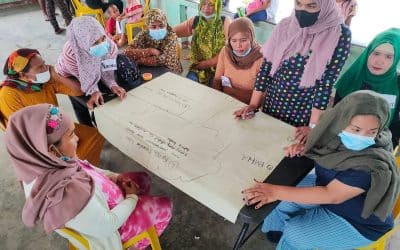InAsia
Insights and Analysis
Are Cambodians Better Informed in the Internet and Facebook Era?
January 11, 2017
For the first time, the internet has surpassed traditional media as the main source of news for Cambodians, according to The Asia Foundation’s 2016 annual survey on mobile phones and internet usage. This has significant implications in terms of connectivity and information access in Cambodia: just three years ago, only 15 percent of people said they received their news from Facebook or other online sources, compared to 30 percent today.

96 percent of Cambodians now own a phone and 48 percent own a smartphone, with urban respondents more likely to have access to the internet on their own phone than their rural counterparts, according to The Asia Foundation’s new survey. Photo/Ian Taylor
The survey, based on 2,061 interviews across Cambodia, found that 96 percent of Cambodians now own a phone and that 48 percent own a smartphone, a 21 percent increase from 2015. Thirty-seven percent of respondents said they use or have used the internet, and 33 percent said they accessed the internet using their own phone. Forty-eight percent said they have used Facebook while 37 percent of Cambodians indicated that they used Facebook on their own phone.
With greater access to the internet, Cambodians now have more choices in terms of where information comes, from instead of relying only on the state-controlled media. However, having access to more information does not necessarily mean that people are better informed. In one of many examples (and certainly not unique to Cambodia), last week, a story about canned fruit produced in Thailand being contaminated with HIV/Aids went viral on Facebook in Cambodia. The incident prompted the Thai embassy in Cambodia to issue a statement to clarify that the message was a hoax.
Cambodians face a new challenge in navigating this online space and deciphering what content is trustworthy, particularly as the campaign season heats up ahead of local elections scheduled for June 2017 and national elections in 2018. In addition, online censorship appears to be on the rise as Cambodians exercise their online freedom. Recently, the president of the main opposition party, Sam Rainsy, and two of his Facebook page assistants were sentenced in absentia to five years in prison for being accomplices to another opposition lawmaker who posted a video on Facebook that cited inaccurate border treaty information and criticized the government.
The survey also found a strong correlation between education and mobile internet usage: 90 percent of university students and graduates access the internet on their phone, while only 16 percent of those with no schooling do so. The findings also suggest that urban respondents are more likely to have access to the internet on their own phone than their rural counterparts (42% vs. 27%). Some are concerned that such differences in connectivity could exacerbate emerging social, cultural, and political divides among socio-economic groups, especially between Cambodians living outside provincial centers and those living in highly urban areas like Phnom Penh.
In a more positive trend, more Cambodians are writing and reading on smartphones, activities that are not very common outside of school or work, the findings show. The study found that 76 percent of respondents had a phone with Khmer-script-enabled, a 160 percent increase from 2013.Thirty-eight percent of respondents claimed that they have written in Khmer script on their phones at some point, a 269 percent increase from 2013, while 49 percent said they have read something in Khmer script on their phones at some point, suggesting a 354 percent increase from 2013, the study found.
With the fast-changing smartphone and internet landscape in Cambodia, The Asia Foundation is tapping into these new opportunities to better reach Cambodians. For instance, the Foundation’s Let’s Read! initiative has brought together local authors, illustrators, designers, and coders to produce a new generation of children’s e-books in Khmer language to support reading outside of the classroom among children by putting more Khmer content online. (Read more about the project here.)
The survey also shows that the gender gaps in accessing smartphones and the internet are gradually closing. Forty-three percent of those who own a smartphone are women. The gap is closing faster for the younger population aged 15-24 years old, with 46 percent of women owning a smartphone in comparison to 54 percent of men. But when it comes to accessing the internet, men are much more likely to be online than women (65% vs. 35%). For Facebook, the percentage is closer between women and men (42% versus 58%).
Last November, The Asia Foundation supported Google Developer Group Festival (GDG DevFest) in Cambodia, which recruited university students to join a hackathon to develop mobile applications to address the issue of violence against women. Three winning teams were selected and are receiving support from TEKHUB, a business incubator that helps support technology startups for social good in Cambodia by providing co-working space and networking and mentoring opportunities.
As more Cambodians go online, it’s important that policymakers create a regulatory environment that supports the opportunities this new connectivity brings. This could start with making sure the ongoing draft law on cybersecurity allows for freedom of expression online.
The 2016 “Mobile Phones and Internet Use in Cambodia” survey is conducted by Open Institute and supported by The Asia Foundation and USAID’s Development Innovations.
Menghun Kaing is a program officer for The Asia Foundation in Cambodia. The views and opinions expressed here are those of the author and not those of The Asia Foundation or its funders.
About our blog, InAsia
InAsia is posted and distributed every other Wednesday evening, Pacific Time. If you have any questions, please send an email to [email protected].
Contact
For questions about InAsia, or for our cross-post and re-use policy, please send an email to [email protected].The Asia Foundation
465 California St., 9th Floor
San Francisco, CA 94104
The Latest Across Asia
News
April 25, 2024
Program Snapshot
April 18, 2024
News
April 17, 2024

2024 Lotus Leadership Awards
Thursday, April 25, 2024, New York City
The Lotus Leadership Awards recognize contributions towards gender equality in Asia and the Pacific







0 Comments